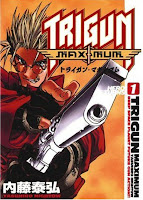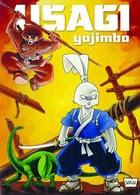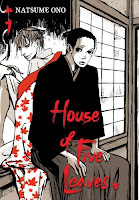My News and Reviews
Things are always slow at Experiments in Manga towards the end of the month, and this week was no exception. I posted March’s Bookshelf Overload and then there’s the monthly manga giveaway. This month I have a brand new copy of Old Boy, Volume 1 that I’m giving away. The winner will be randomly selected this coming Wednesday and not many people have entered yet. Old Boy is an Eisner award winning series that’s definitely worth checking out. Enter Manga Giveaway: Omnivorous Old Boy before it’s too late!
This week’s interesting online finds include an interview with one of my favorite translators Alexander O. Smith on the podcast if you’re just joining us. He talks about Harmony, which is up for a Philip K. Dick Award, and translating video games, among other things. Apparently, he is currently working on the translation of Miyuki Miyabe’s Ico: Castle of Mist for Haikasoru. (Smith also translated Miyabe’s Brave Story and The Book of Heroes.) I also found an interview with Japantor Radio’s Zac Bentz on Nihongaku. I love Japanator Radio, so it was nice to read what Zac had to say about it. I only discovered the podcast recently, but it’s been airing for over three years now.
Two more things I want to bring attention to: Manga Bookshelf’s Don’t Fear the Adaptation feature recently focused on House of Five Leaves. I love, love, love this anime and really hope we get a DVD release of it. And finally, NPR’s Talk of the Nation had a segment last Monday with Donald Keene and Kimiko Hahn looking at Japanese literature with reading recommendations in light of the recent earthquakes and tsunami: Books to Help You Understand Japan. The recommendations primarily focus on traditional and classic works.
Actually, there’s one more thing I want to mention. Anime and Manga Bloggers for Japan is still going strong. We’ve almost raised $5,000 for Shelter Box and Doctors without Borders. It would be fantastic if we could reach that goal or more. If you are able, please consider donating.
Also, added to the Resources page: Ain’t It Cool News Anime, Blog of the North Star, Diary of a Bookworm, and Yaoi 911
Quick Takes
 Trigun, Volumes 1-2 by Yasuhiro Nightow. The first few volumes of Immortal Rain share quite a few similarities with Trigun, which is the series that came first. Except that I adore Immortal Rain and can barely stand Trigun. I don’t really like the art at all (although there are some interesting character designs) and found both it and the story extremely difficult to follow. Things start to become a bit more coherent and interesting towards the end of the second volume, but then the series ends abruptly. I preferred the science fiction elements of the story over the more generic Western elements but ultimately Trigun just didn’t work for me.
Trigun, Volumes 1-2 by Yasuhiro Nightow. The first few volumes of Immortal Rain share quite a few similarities with Trigun, which is the series that came first. Except that I adore Immortal Rain and can barely stand Trigun. I don’t really like the art at all (although there are some interesting character designs) and found both it and the story extremely difficult to follow. Things start to become a bit more coherent and interesting towards the end of the second volume, but then the series ends abruptly. I preferred the science fiction elements of the story over the more generic Western elements but ultimately Trigun just didn’t work for me.
 Trigun Maximum, Volumes 1-7 by Yasuhiro Nightow. This series is such an improvement over the original manga. Trigun Maximum begins two years after the events Trigun. The story is clearer but still somewhat difficult to follow. The fight sequences are also difficult to follow, but at least the art looks a lot better than it did in the original series. I like Trigun Maximum much more than I did Trigun, but the manga still frustrates me. I felt that I had to put too much effort into trying to understand what was going on. But, I do like the characters and the story that I was able to figure out I did enjoy. I might give the anime a try.
Trigun Maximum, Volumes 1-7 by Yasuhiro Nightow. This series is such an improvement over the original manga. Trigun Maximum begins two years after the events Trigun. The story is clearer but still somewhat difficult to follow. The fight sequences are also difficult to follow, but at least the art looks a lot better than it did in the original series. I like Trigun Maximum much more than I did Trigun, but the manga still frustrates me. I felt that I had to put too much effort into trying to understand what was going on. But, I do like the characters and the story that I was able to figure out I did enjoy. I might give the anime a try.
 Usagi Yojimbo: The Special Edition by Stan Sakai. I’ve never actually read any Usagi Yojimbo until now. The series began in 1987 and is still going. Fantagraphics’ The Special Edition is a marvelous collection of the first seven trade volumes plus a ton of great extras, including a cover gallery and interviews with Sakai. The influence of samurai films on Sakai’s work is obvious and the references and nods are delightful. (Lone Goat and Kid, anyone?) Usagi is inspired by Miyamoto Musashi and Sakai has put a lot of research into the creation of his anthropomorphic version of Edo era Japan. I really enjoyed Usagi Yojimbo and plan on reading more.
Usagi Yojimbo: The Special Edition by Stan Sakai. I’ve never actually read any Usagi Yojimbo until now. The series began in 1987 and is still going. Fantagraphics’ The Special Edition is a marvelous collection of the first seven trade volumes plus a ton of great extras, including a cover gallery and interviews with Sakai. The influence of samurai films on Sakai’s work is obvious and the references and nods are delightful. (Lone Goat and Kid, anyone?) Usagi is inspired by Miyamoto Musashi and Sakai has put a lot of research into the creation of his anthropomorphic version of Edo era Japan. I really enjoyed Usagi Yojimbo and plan on reading more.
 Ze, Volumes 3-4 by Yuki Shimizu. As adorable and awkward as Raizou and Kon’s relationship is in the first two volumes of Ze, Genma and Himi’s relationship in volumes three and four is just as dark and brutal. Genma really has some serious issues to work out, which is very unfortunate for his kami Himi. Granted, most people in the Mitou family have issues. More details are revealed regarding kami and their creation in these volumes. Additional characters are introduced, too, and lighten things back up a bit after Genma and Himi’s intensity. There’s even an honest to goodness threesome in volume four, something I haven’t seen much of in manga licensed in English.
Ze, Volumes 3-4 by Yuki Shimizu. As adorable and awkward as Raizou and Kon’s relationship is in the first two volumes of Ze, Genma and Himi’s relationship in volumes three and four is just as dark and brutal. Genma really has some serious issues to work out, which is very unfortunate for his kami Himi. Granted, most people in the Mitou family have issues. More details are revealed regarding kami and their creation in these volumes. Additional characters are introduced, too, and lighten things back up a bit after Genma and Himi’s intensity. There’s even an honest to goodness threesome in volume four, something I haven’t seen much of in manga licensed in English.
 Monster, Episodes 61-74 directed by Masayuki Kojima. I finally got around to finishing the anime adaptation of Naoki Urasawa’s Monster. It wasn’t a terrible adaptation, and I’m happy to see just about any version of Urasawa’s work, but it doesn’t have much life of its own. I think it tried to be too true to the original manga and it simply didn’t work as well. The pacing needed for a television series is not the same that is needed for a written series and the anime comes across as being slow and unfocused. Ultimately, and perhaps not too surprisingly, I prefer the manga over the anime. But, I am glad that I took time to watch the anime. It’s not bad, it’s just not as good as I wanted it to be.
Monster, Episodes 61-74 directed by Masayuki Kojima. I finally got around to finishing the anime adaptation of Naoki Urasawa’s Monster. It wasn’t a terrible adaptation, and I’m happy to see just about any version of Urasawa’s work, but it doesn’t have much life of its own. I think it tried to be too true to the original manga and it simply didn’t work as well. The pacing needed for a television series is not the same that is needed for a written series and the anime comes across as being slow and unfocused. Ultimately, and perhaps not too surprisingly, I prefer the manga over the anime. But, I am glad that I took time to watch the anime. It’s not bad, it’s just not as good as I wanted it to be.



















